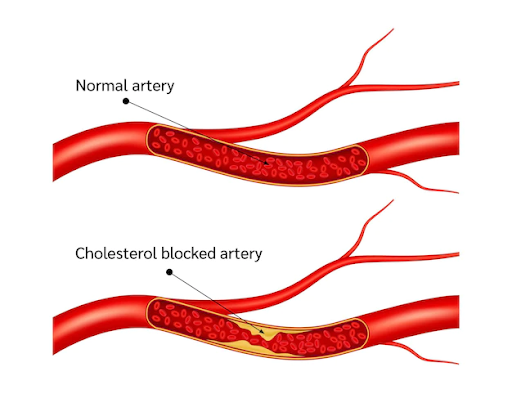What Increases Risk Of Coronary Disease? Management Plans For Coronary Heart Disease
Overview:
The heart has two blood vessels: One that pumps blood to the heart (coronary artery) and the other that leaves the heart (coronary veins) with purified blood. Due to progressive plaque deposition in the coronary artery, the lumen (arterial passage for blood flow) narrows, building excess pressure on artery walls. The plaque obstructs blood flow and reduces oxygen supply to the heart. This creates pressure on the heart to function without adequate oxygen and blood supply, which may lead to its collapse, generally called a heart attack.
Here are some facts about coronary artery disease CAD:
- The prevalence of Cardiovascular Heart disease( CHD) is continuously rising in India. The Registrar General of India( RGI) reported that CHD has led to 17% of total deaths and 26% of adult deaths in 2001-2003, which increased to 23% of total and 32% of adult deaths in 2010-2013.
- When the occlusion(blockage) of the artery is increased to 75%, it becomes critical.
- It may cause angina pectoris or chest pain.
- Or it may also lead to an asymptomatic heart attack called silent Ischemia.
What leads to the narrowing of the coronary artery, Or what causes CAD?
Coronary heart disease is caused by plaque built in the coronary arteries. The plaque is cholesterol deposition, a waxy substance that keeps depositing, calcifying, and thickening on arterial walls. Naturally, the increased thickness of plaque narrows the lumen and surmounts extra pressure on arterial walls. These deposits also prevent the smooth flow of blood, causing insufficient oxygen supply in the heart.

Cholesterol deposits for the following reasons:
- Fatty food consumption
- Inadequate or lack of exercise
- Overweight
- Unbalanced metabolism due to another comorbidity
- Alcoholism
Punechelation can help treat coronary heart disease with EECP Treatment. The blood vessels are stimulated, and the lumen is widened to maintain smooth blood flow into the heart.
Risk Factors That Increase Chances of Coronary Heart Disease
A person is most prone to developing coronary heart disease if they have:
- Hyperglycemia: Diabetes Mellitus or High blood sugar
- High Blood pressure
- Hyperlipidemia: High Cholesterol
- Unstable metabolism
- Stressful life and jittery behavior
- Polluted atmosphere
- Unhealthy eating habits
Symptoms of Coronary Disease
According to the Centers for Disease Control and Prevention CDC, the following are some symptoms of having coronary disease:
- Chest pain or discomfort in the chest
- Pain and discomfort or arms
- Shortness of breath
- Feeling sick, cold sweat, or nausea.
Diagnosis
Doctors may prescribe a series of diagnostic tests to determine the cause and extent of coronary disease. The test includes:
- Resting ECG to learn about left ventricular hypertrophy, possible Q-waves, ST-T changes, etc.
- Positron emission tomography to see through small perfusion defects
- Radionuclide ventriculography
- Cardiac Catheterization to note blocked vessels
- Coagulation studies
- A blood test of fasting levels of blood cholesterol, blood sugar, and lipoproteins.
Management plans for coronary heart disease
- Medications-The following medications can be prescribed to prevent chest pain or angina pectoris.
- Blood-thinning medications such as aspirin reduce the blood clotting tendency in blood.
- Anti-cholesterol drugs such as statins reduce the thickening of the arterial wall.
- Beta-blockers reduce the oxygen demand by the heart, lower heart rate, and blood pressure. Calcium channel blockers can also be prescribed along with beta-blockers.
- Ranolazine- a special medication to treat angina.
- Chelation Therapy or artery clearance therapy is a medical treatment for angina pectoris. Poona Preventive Cardiology Center PPCC provides Chelation therapy that complies with standardized ICBMT guidelines. Chelation therapy can be extremely helpful in preventing severe angina or chest pain.
- Surgery– In medical emergencies, the doctors may prescribe surgical treatment for CAD. The surgery will include
- Angioplasty with stent placement to broaden the arterial wall and increase lumen width to increase blood flow passage.
- Coronary artery bypass– creating a graft to re-route the blood supply away from the diseased artery.
- EECP Therapy– Enhanced External Counter Pulsation(EECP) can be an option when all other treatment options have failed to relieve persistent chest pain symptoms. It stimulates the artery to create a natural bypass inside narrowed or affected artery/arteries.
- ESMR: Extra Corporeal Shock wave Myocardial Revascularization is a new form of non-invasive cardiac treatment. It works by improving the blood supply to the heart. Being a non-invasive approach to cardiac treatment and with higher success rates it is quite a popular treatment method.
We have more options, such as HBOT and Ozone treatment to treat CHD. Visit PPCC to learn about your heart treatment options.



Comments
Post a Comment